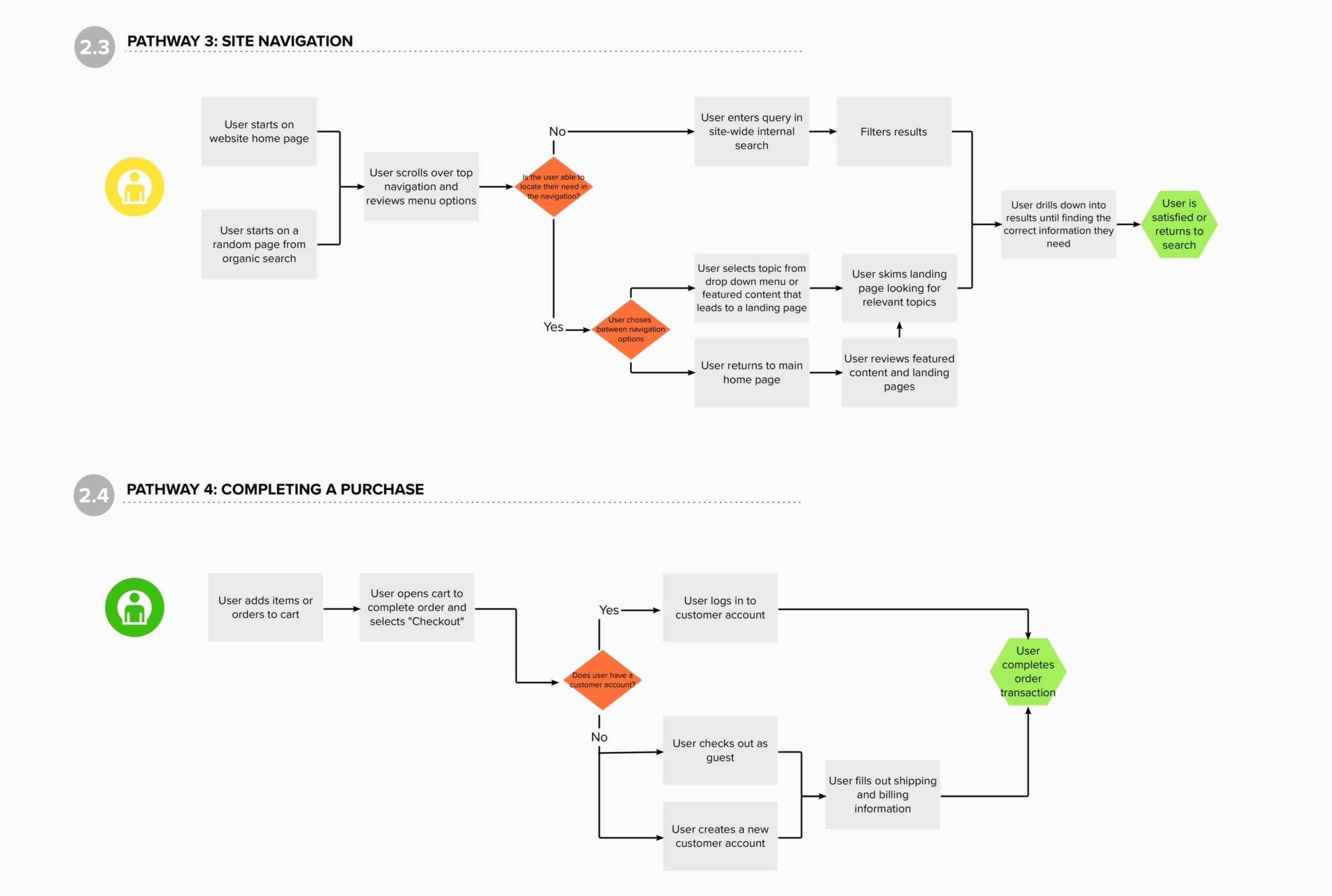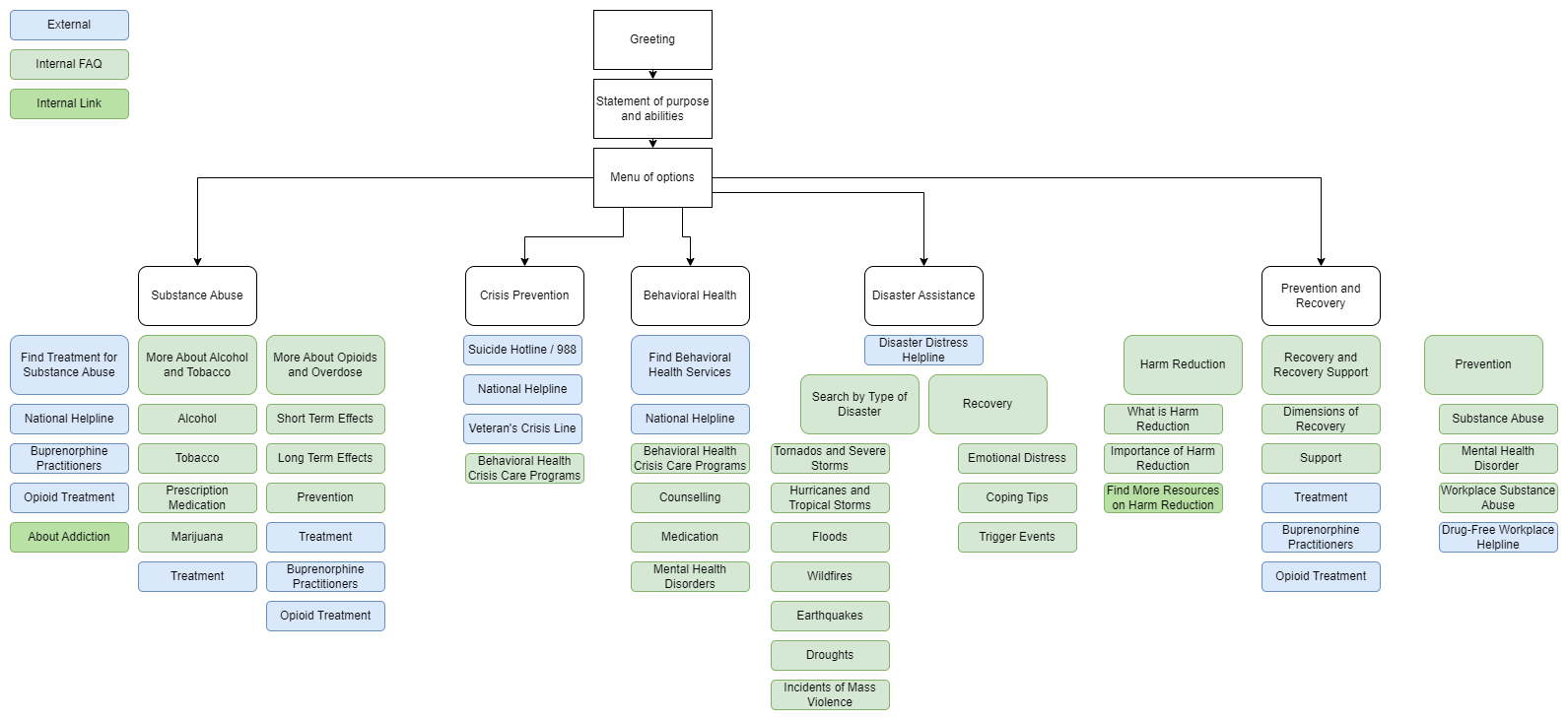Building chatbots professionally since January 2019.
A recognized subject matter expert in chatbots and cross-channel AI automated customer services.
Chatbots &
Conversational AI
Development Process
How I start a chatbot project from scratch.
Purpose-Driven Development
When a client comes to me asking for a chatbot, my first question is: Why?
The most important thing to know when building a conversational tool is how it will help your users. To define this purpose, I start with a workshop or a series of interviews with stakeholders and developers. In this research phase, we work together to lay out all the ways in which an AI-driven tool can bring value to their project in a way that other digital tools can not. This is also when I map out all the databases or other systems it needs to integrate with in order to succeed.
Read more advice on how to start a new chatbot project in my article: Need a chatbot? Start with a clear vision of how it will help.
Parts of my customized stakeholder workshop on launching a chatbot, where we set expectations and gather requirements together. One option is to walk through sample user pathways and flag where a chatbot other other automated tool would be of assistance to users.
Communication is Key
It goes without saying that having conversations is a big part of building a conversational tool.
At every step of the way I keep both the project stakeholders and the end users in mind. Often I will conduct audience research at the beginning of development to determine how the user’s end goals align with the functionality of the tool. If I have access to a subject matter expert (SME) or a group of people in the target demographic, I will do interviews and develop personas to do user testing with once content development has begun.
I also make sure to talk to all the other teams whose work this development may touch upon, to ensure I have the most complete picture of how systems integrations will need to work.
Process diagram for all the systems and software integrations involved in implementing a phone IVR.
A persona profile developed for mock conversational testing of the HIV.gov chatbot.
Staying on Top of Emergent Technology
The field of AI is rapidly evolving, with new tools and advances cropping up almost daily. In order to stay on top of trends, I perform an environmental scan and heuristic evaluation of chatbot platforms multiple times a year.
At the start of a new project, I’ll take this evaluation and compare it to my client’s priorities for their tool. This helps ensure that the chatbot never has to sacrifice value because they started building on a platform that wasn’t the right fit for their goals or budget. Even in the event the tool has to migrate to another platform, there’s a clear line of succession to the next most aligned service.
My standard tool evaluation looks at development costs and the level of effort involved in standing up a type of function. I then work with stakeholders to decide how vital each function is to the tool performing it’s purpose.
Design Process
My approach to conversational design and the information architecture of chatbots.
Conversation Architecture
While conversational tools have much more flexibility in how content is navigated, the way that conversation is structured is still important to consider in getting users to their end goal while mitigating potential frustration.
Depending on the tool chosen for the project, I’ll create a prototype diagram that outlines the architecture of core flows and logic that determine what direction the conversation needs to go. This helps highlight where pain points and bottlenecks could occur. I start with building on this process diagram every time there’s a request for new functionality.
I also use this prototype to help pinpoint what data points can be measured to align with the client’s key performance indicators (KPIs).
Conversational development for adding a new e-mail callback request function for a call center’s virtual assistant.
Mapping out categories of internal and external resources available for a virtual assistant for the Substance Abuse and Mental Health Services Administration.
Write For Your Audience By Writing With them
When it comes time to write the actual content - the conversation script - there’s three major things I keep in mind:
Write in plain language. This is a core tenant of writing for web, but is even more important when writing for a conversational tool. Making content as short and simple as possible keeps it feeling like a real conversation.
Many questions, one answer. A query can come in many forms with almost infinite phrasing possibilities. Instead of getting bogged down in writing a perfect answer for every possible question, I focus on grouping questions with similar themes and developing a higher level response that answers all of them.
Be a springboard. The answer a chatbot gives doesn’t have to be an encyclopedic end-all, it’s just a beginning. When developing scripts, I split content into as small and easy to digest pieces as possible, then link out to more detailed web resources when it gets nuanced. This allows the user to decide for themselves just how much information they need.
Draft script for a virtual assistant for grant recipients of the US Department of Housing and Urban Development.
Scripts in final review for a social media smoking cessation assistance chatbot for Smokefree.gov.
Think Like a User
Content Strategy is all about the big picture. But it’s also necessary to come down from that bird’s eye view and consider what it will look like at the ground level - from the user’s perspective.
To do this, I design interactive mockups focused on how the tool will be laid out on the front end. This helps get a sense for where content needs to be adjusted to improve readability or the overall flow. Including this mockup as part of requirements documentation also makes conversations with developers that much easier.
The prototype stage is the perfect time for user testing. Putting these mockups in front of a real end user, SME, or tester using a persona will work out all the knots that normally wouldn’t be caught until a beta is launched.
Mockups from an internal-use virtual assistant that helps call center agents access resources for reporting and recovering from fraud targeting the elderly.
Content Management
How I train an AI with a data-driven approach.
Human Reinforcement
It’s tempting to treat AI like a set-it-and-forget-it tool that will manage itself. While modern AI is certainly capable of learning on its own, that doesn’t account for bad faith actors and misinformation.
To keep an AI-based tool focused on its core purpose, it’s vital for a human to be the one making decisions about what makes it into it’s training. Part of the operations and maintenance of a chatbot is to monitor for UMM errors: unsupported, missed, and misunderstood. Missed and misunderstood errors get retrained, and unsupported errors are taken back to the client to determine if it warrants new development.
Read more about the importance of human reinforcement in my article: Safe and effective strategies for applying generative AI to your mission.
An example of generating training phrases in an older NLP engine used for the Smokefree chatbot prototype.
Using phrase clustering to review patterns in real user inputs and make decisions about what training makes it into the NLP engine.
Learn When the AI Learns
Nothing makes you an expert faster than training an AI to be an expert.
By leveraging search analytics and social media listening, I look for patterns in the way real users are talking about the content. The great thing about training an AI is you can incorporate all the slang, lingo, and shorthand you want into your NLP engine without risking your actual content coming off as unprofessional.
When new information emerges in the chatbot’s field of expertise, it’s far easier to stand up a quick 2-3 sentence response than it is to publish an entire article. Using a conversational tool as a way to keep users on top of rapidly changing content prevents the more in-depth response from being rushed.
Example of how I manage entity mapping to reduce the manual labor involved in generating training phrases while also improving the AI’s understanding of contextual keywords.
Data-Driven Change
How do you determine if a conversational tool is doing a good job? It’s more difficult than you might think.
While you can measure the general success of web content by looking at trends in traffic, conversational content needs to also consider the success of the AI in how it’s processing input and output. Like UMM error monitoring, looking at pathways users take from one intent to another helps highlight where the AI may be optimized for a smoother user experience. Adding sentiment analysis to the mix shows where users are getting stuck or frustrated.
A data dashboard is a valuable asset in understanding the performance of a conversational tool. To start, I build my dashboards to look at unrecognized and low confidence queries to look for opportunities to improve the AI’s training. Then I consider my client’s KPIs and how I can best visualize the metrics that help pinpoint where content or architecture changes are needed most.
The baseline metric I start with for measuring AI is confidence rate. I look at interactions below a certain threshold of confidence and see where training improvements can be made to prevent similar errors in the future.
Success Stories
Publicly available chatbots and virtual assistants I’ve worked on.
HIV.Gov chatbot
2019–Present
As AI team lead and conversational architect, I manage the design and content for an AI-powered virtual assistant for HIV.gov. This tool helps visitors to the website answer questions about HIV testing, treatment, and prevention, and connects them to local healthcare services.
Responsible for all ongoing content operations and maintenance including AI reinforcement training, entity mapping, analytics review, best practice heuristic evaluation, governance, documentation, and task delegation.
Version 1.0 built in Amazon Lex launched in June 2021. Updated Version 2.0 migrated to Google Dialogflow launched in April, 2023. Presently the chatbot can answer over 130 unique questions about HIV, with more content being developed in agile cycles.
-
Google Dialogflow
Dashbot
Amazon Lex
BotMock
ChatGPT
Google Bard
-
Human reinforcement training
Entity mapping
Sentiment Analysis
Pathway analysis
Keyword research
Persona testing
Usability testing
Phrase cluster utterance training
In addition to being the conversational architect and content manager, I also designed the HIV Chatbot avatar.
The newly updated Version 2.0 of the HIV Chatbot, with service locator function built into the chat.
Version 1.0 was launched in beta in 2021.
The original prototype of content was mapped out in BotMock before committing to an NLP engine.
While the team ultimately decided on a default full-screen application due to the detailed nature of the content and other functionalities requiring a larger horizontal space, a traditional pop-up widget was designed as well.
Child Welfare Information Gateway
2020–Present
As AI team lead and conversational architect, I developed, deployed, and now provide ongoing maintenance of a multilingual phone IVR and SMS-based automated system built in OneReach.ai. This tool assists callers to the Child Welfare Information Gateway hotline in connecting to critical resources when agents may not be available.
Responsible for knowledge management, AI training, Agile project management, Kanban, client communications, data management, and reporting. This integration of multiple AI tools has a custom-built data dashboard that is tailored to the client’s KPIs and also exports to a larger Tableau dashboard for the larger HHS contract that owns Child Welfare Information Gateway’s web tools.
Version 1.0 was officially launched in June 2020 and has reduced call center agent intervention by 38%.
Interact with this live virtual assistant by calling the hotline at 1-800-394-3366 or by texting the FAQ chatbot directly at 1-720-594-6513. The virtual assistant is also available in Spanish as a rich web chat.
-
OneReach.ai
NICE CXone
Valero
Amazon Web Services
JIRA
Visio
Draw.io
-
Human reinforcement training
Entity mapping
Keyword research
Persona testing
Smoke & stress testing
Automated quality assurance testing
Tree-based & conditional logic navigation
The texting chatbot can answer common child welfare questions and provide resources from childwelfare.gov.
In order to integrate with the larger Child Welfare data reporting dashboard, I mapped out where every data field we collected in our internal metrics was logged in a user pathway diagram through the phone IVR.
To ensure users are being sent the best available resources, I built an automated link-checker tool that allows content managers to quickly identify URLs with potentially problematic status codes.
So I wouldn’t become a bottleneck that prevented urgent content edits from being made, I built a rich web chat tool that allows content managers to make immediate changes to FAQ responses without forcing them to navigate the developer back-end of the NLP engine.
Software Specialization
The Natural Language Processing (NLP) engines I am most experienced with.
Google Dialogflow
OneReach.ai
Amazon Lex
Other Software Experience
ChatGPT
Claude
IBM Watson
Jasper.AI
Microsoft Copilot
Chatfuel
Midjourney
Amazon Bedrock
Google Bard / Gemini
Adobe Firefly
Flow XO
Azure Bot Services
ManyChat
Dashbot
BotMock
Notion AI
Publications
Articles I have published in the field of conversational AI and blogs featuring chatbots I’ve worked on.
Safe and Effective Strategies for applying generative AI to your mission.
June 27, 2023
By Cassandra Bachman
Deciding whether to use artificial intelligence (AI) no longer seems the most important technology question for leaders and business strategists. It’s clear AI is here to stay so, today, the big question is “what AI model is best for my needs?”
Need a chatbot? Start with a clear vision of how it will help.
March 15, 2023
By Cassandra Bachman
Conversational AI can be a mission game changer, elevating humans to higher value work while improving service delivery for users. But, before you rush to plug a chatbot or virtual agent into your program, it’s essential to follow these three best practices to ensure success.
HIV.GOV Launches New Chatbot Tool
June 02, 2021
From HIV.gov
HIV.gov has launched the prototype of a new chatbot tool that is accessible from the HIV.gov site at bot.HIV.gov.





























